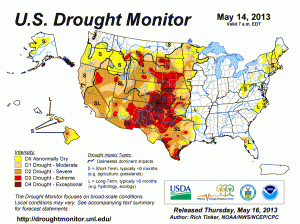 Long, hot summers in California—especially in the interior valleys—tend to spread worries and fears across the state. That’s because running low on water makes farmers everywhere question how well their crops will do and how much money they stand to lose as a result of irrigation water cutbacks.
Long, hot summers in California—especially in the interior valleys—tend to spread worries and fears across the state. That’s because running low on water makes farmers everywhere question how well their crops will do and how much money they stand to lose as a result of irrigation water cutbacks.
According to AgAlert, “the season’s final survey of the Sierra Nevada snowpack … found only 17 percent of average levels. At the same time, the U.S. Bureau of Reclamation reported its water transfer pumps in the Sacramento-San Joaquin Delta were operating at about 20 percent of capacity, due to the dry conditions combined with restrictions intended to protect fish species. San Luis Reservoir, a summer supply pool for both the State Water Project and the federal Central Valley Project, stood only about 50 percent full.”
These low water levels often force farmers, ranchers, and vineyard operators to find ways to conserve water and make the most of what they have available. Take a look at the tips for conserving water below, and know that the process isn’t always a quick fix, but ultimately your efforts will produce noticeable results.
Water Conservation Techniques
- Effective watering techniques – This is a great place to start when trying to save water, and Certified Landscape Irrigation Auditors can assist you if need be. Effective watering techniques include watering early in the day to reduce evaporation loss and watering less frequently (but for longer amounts of time). It’s also imperative to regularly check all hoses and sprinklers for leaks, and you can easily reduce water waste by making sure all sprinklers are positioned correctly and watering plants only. You can even ask your water provider if they’re currently offering any coupons or discounts on water-saving irrigation equipment.
- Eliminate weeds – Weeds compete with your other plants for water. Placing landscape fabric between the soil and your mulch will minimize weeds and allow for more of the water to go where it’s supposed to.
- Rain barrels – This is another good way to minimize the effects of a drought. Collecting rainwater will certainly increase the amount of available water.
- Water-conserving irrigation systems – There are several options to consider if you’re planning a water-conserving irrigation system: (1) A drip system, (2) furrow irrigation, (3) alternate furrow irrigation, and (4) surge irrigation—to name a few. IrrigationTutorials.com states, “While sprinkler systems are around 75-85 percent efficient, drip systems typically are 90 percent or higher.” Implementing the right irrigation system will not only reduce soil percolation, but also will minimize surface runoff losses.
- Reduce fertilizer use – Using compost instead of fertilizers will increase water retention and decrease erosion. Moreover, adding mulch to the soil surface will increase the penetrability of clay soils, increase the water-holding capacity of sandy soils, and reduce the amount of water lost by evaporation.
- Provide partial shade – If you have plants in containers, then you can prevent them from drying as quickly as they would in warmer, windy areas by providing some shade.



You must log in to post a comment.